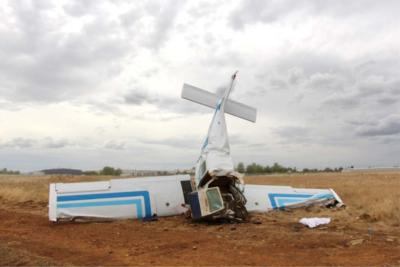Sat, Jun 11, 2022
Performed Two Attempted Takeoffs And Aborted Both Due To Performance Issues
Location: Oroville, CA Accident Number: WPR22FA196
Date & Time: June 2, 2022, 12:18 Local Registration: N7641R
Aircraft: Beech 19A Injuries: 2 Fatal
Flight Conducted Under: Part 91: General aviation - Personal

On June 2, 2022, about 1218 Pacific daylight time, a Beechcraft 19A Musketeer airplane, N7641R, was substantially damaged when it was involved in an accident near Oroville Municipal Airport (OVE), Oroville, California. The pilot and pilot-rated passenger were fatally injured. The airplane was operated as a Title 14 Code of Federal Regulations Part 91 personal flight.
According to a video of the accident flight captured by a witness, who was also a student of the accident pilot, the pilot and passenger completed an engine run-up and subsequently taxied to runway 13. The engine sounded smooth and continuous as the airplane lifted off the runway in about 1,300 ft and transitioned into a climb. Approximately fifteen seconds later the airplane began to descend. The airplane started another climb about four seconds later, which was immediately followed by a right turn.
The airplane’s rate of turn began to increase during the turn at which time the video ceased. The witness reported that the airplane impacted the ground seconds after he terminated the video to assist the occupants of the airplane.

The witness reported that he flew the accident airplane with the pilot about 2 weeks prior to the accident. After an uneventful preflight inspection and engine run-up they taxied to runway 31 where they began a ground run. They performed two attempted takeoffs and aborted both due to performance issues. According to the witness, the pilot and pilot-rated passenger had planned to fly the airplane on the day of the accident to troubleshoot the performance deficiency.
The airplane came to rest in an approximately 40° nose down attitude on a heading of about 097° magnetic, about 500 ft south of the departure end of runway 13. All major components were accounted for at the accident site. The left wing remained attached to the fuselage, and the right wing was partially separated at the wing root. The fuselage frame was deformed about midspan and the tail was canted slightly left of the fuselage. Both the stabilator and rudder remained connected to the empennage at their attachments. The engine remained attached to the engine firewall, which was wrapped around the engine accessory case. Both propeller blades remained attached to the propeller hub, which was still connected to the engine crankshaft.
More News
Circle To Runway (Runway Number) Used by ATC to inform the pilot that he/she must circle to land because the runway in use is other than the runway aligned with the instrument appr>[...]
Aero Linx: National Aviation Safety Foundation (NASF) The National Aviation Safety Foundation is a support group whose objective is to enhance aviation safety through educational p>[...]
At Altitude Of About 250-300 Ft Agl, The Airplane Experienced A Total Loss Of Engine Power On November 6, 2024, at 1600 central standard time, a De Havilland DHC-1, N420TD, was inv>[...]
From 2009 (YouTube Edition): Three Hour Flight Was 'Flawless' -- At Least, Until Mother Nature Intervened For anyone who loves the aviation business, this was a VERY good day. Afte>[...]
Also: AMA Names Tyler Dobbs, More Falcon 9 Ops, Firefly Launch Unsuccessful, Autonomous F-16s The Air Force has begun ground testing a future uncrewed jet design in a milestone tow>[...]
 ANN's Daily Aero-Term (05.05.25): Circle To Runway (Runway Number)
ANN's Daily Aero-Term (05.05.25): Circle To Runway (Runway Number) ANN's Daily Aero-Linx (05.05.25)
ANN's Daily Aero-Linx (05.05.25) NTSB Prelim: De Havilland DHC-1
NTSB Prelim: De Havilland DHC-1 Classic Aero-TV: The Boeing Dreamliner -- Historic First Flight Coverage
Classic Aero-TV: The Boeing Dreamliner -- Historic First Flight Coverage Airborne-NextGen 05.06.25: AF Uncrewed Fighters, Drones v Planes, Joby Crew Test
Airborne-NextGen 05.06.25: AF Uncrewed Fighters, Drones v Planes, Joby Crew Test




